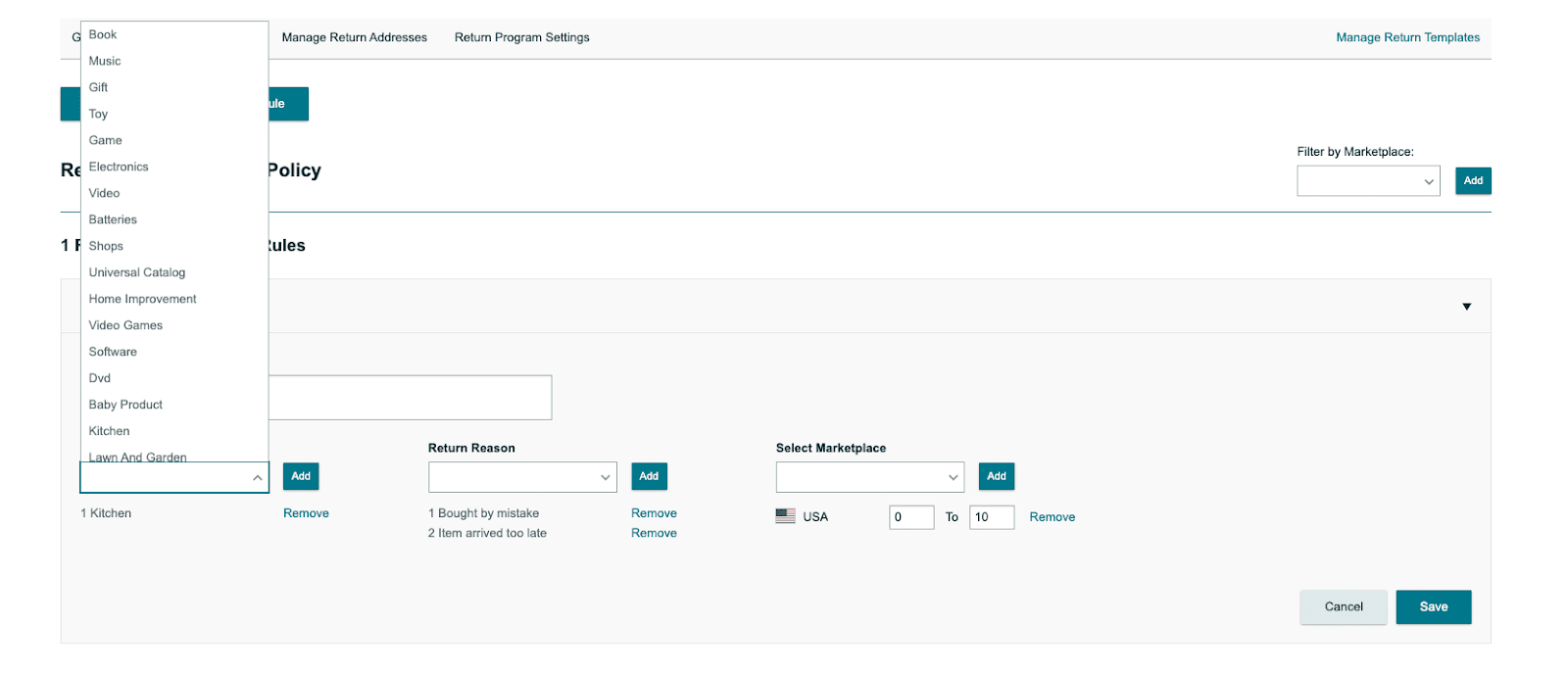A survey found that if a customer had a positive experience with a store’s return policy, they were more likely to shop there again. This percentage was as high as 92%. Even if you sell your items online, such as on the Amazon marketplace, where customers have the option to return their purchases at their own expense, processing returns can still be an expensive process.
The question that arises therefore is how you can ensure that you meet the needs of your customers without putting further strain on the resources that are already stretched thin in your business.
At that time, Amazon offers third-party sellers the option of offering returnless reimbursements.
What is Amazon’s returnless refund?
Source – Zonguru
There are certain types of refunds on Amazon that are referred to as “returnless refunds.” These refunds enable sellers to compensate customers for incomplete or damaged orders without requiring the buyers to send the product back. The returns dashboard in Seller Central allows vendors to choose whether to offer customers a full refund or to ship out a replacement item in place of the one that was sent back.
Keep in mind, however, that returnless refunds are a voluntary service and that you are not needed to sign up for them in order to get them. In point of fact, you have the freedom to select the products for which you would provide refunds without accepting returns.
Why does Amazon offer returnless refunds to sellers?
Return processing fees on Amazon can sometimes be quite high. You, as the seller, are responsible for paying the cost of the return shipping. If you use FBM, you are responsible for determining whether the item that was returned can be resold or whether it must be discarded instead.
All of this demands an investment of time, energy, and resources. Through the provision of returnless reimbursements, Amazon makes it possible for sellers to save resources and improve the management of their businesses.
Amazon’s goal is to become a customer-focused business, and returnless refunds help the company move closer to achieving this goal. People are able to shop without anxiety when they know that they can get their money back in full if something goes wrong, and they don’t have to worry about how to return the goods either.
Which Amazon marketplaces provide refunds even when items aren’t returned?
Every Amazon market offers refunds even if customers don’t want to send items back. You can therefore choose to receive returnless refunds from within Seller Central whether you sell in the US, UK, Australia, or India.
All Amazon marketplaces give refunds without returns. Consequently, regardless of whether you sell in the United States, the United Kingdom, Australia, or India, you have the option under Seller Central to receive returnless refunds.
Describe the process that takes place within Amazon’s Returnless Refund System.
The operation of the Amazon returnless refund system is governed by a set of regulations that have been predetermined. These standards, which are established by sellers, basically specify the conditions for goods that are eligible for a refund without the requirement of returning them to an Amazon shop.
After receiving a return request from a customer, Amazon first analyses whether or not the circumstances meet the requirements for a returnless refund, and then processes the refund on behalf of the seller. The payment is deducted from the available balance on their account automatically. Prior to the rule’s creation, all orders were processed routinely.
It is possible to define guidelines for returnless refunds for either the full product category or for specific items contained within it. More will be said about this later.
Amazon will take care of all requests for returnless refunds, with the following exceptions: items that are handmade or non-physical, products related to sexual wellness, dental and medical supplies, certified pre-owned timepieces, hazardous and dangerous goods, and Amazon Custom items.
These requests must be manually handled via the buyer-seller message system. The same is true for requests for returns made more than 30 days following the initial purchase.
Returns that are pre-paid, refunds that do not require returns, and free returns
In addition to return-free refunds, Amazon also provides prepaid return shipping as well as free standard shipping for customers who need to send items back.
When they send items back to you that have been prepaid, your customers won’t have to pay for postage right away. Simply purchase a pre-paid postage label from Amazon, attach it on the item, and have it delivered back to you. When you finally get your hands on the merchandise, you can initiate a partial refund by deducting the cost of shipping from the total amount that will be refunded to the customer.
On the other hand, retailers who offer free returns make it possible for customers to return items and receive their money in full. At your option, either all of your products, some of your products, or none of your products at all may be eligible for free returns. With the exception of luggage and bags, all fashion items come with the option to return them at no additional cost.
How long does it take Amazon to process a refund request for an item that cannot be returned?
Amazon typically completes the processing of returnless refunds within one to two business days after the refund request has been submitted. This is a rather speedy process as compared to standard returns, which can take up to five business days after the item has been received to process.
How many returns are permitted by Amazon’s returnless refund policy?
There is technically no return without a refund cap on Amazon. The e-commerce behemoth does random audits on consumer return requests in order to make certain that the provision is not being abused in any way. It has been whispered that Amazon places restrictions on customers whose overall return rate for all orders is at least 10%. It goes without saying that every circumstance will be unique.
The Pros and Cons of Refunds Issued Without a Return
Returnless refunds may appear to be more beneficial for customers, but they also have significant benefits for Amazon business owners, who can use those benefits to their advantage.
They cut down on the costs associated with processing your returns.
This has already been touched on in passing previously in the conversation. The processing of return requests will incur costs. You are responsible for paying the cost of the return shipment, particularly in situations in which items are delivered in error or are found to be defective. When it comes to selling on Amazon, situations like these tend to be very common.
Even if you are convinced that you have shipped the customer the correct product, customers can always find a reason to complain to Amazon, leaving you with no alternative but to comply. If a product allows for free returns, there is not much more you can do with it after you’ve purchased it.
Even though there is nothing unethical about having to pay for returns, there are times when the cost of shipping is higher than the cost of the item itself. After that, you will have to pay additional money in order to replenish the item on the shelves of your Amazon store.
It seems that in this particular scenario, it would be best for you to refrain from processing the return, doesn’t it?
In a manner analogous to this, certain items cannot be resold even after they have been returned by customers. It could be helpful to illustrate this point with a pair of socks. Would you be interested in reselling a customer’s returned pair of socks, which the customer may have tried on in the past?
Then there are the things that have the potential to get damaged.
In a situation like this, the most prudent thing to do is to provide refunds that do not require the item to be returned.
They assist you to economize your time
The processing of returns not only results in financial losses but also consumes a significant amount of valuable time.
As the seller, you are required to wait for the customer to return the item before you can begin the process of processing the refund. This could take a few days, or even up to a week to complete.
After you acquire the item, you must physically inspect it to see if it may be restocked. Once again, if you engage in FBM, this necessitates spending a significant amount of time in the storage facility. All your work can be for naught if the product turns out to be faulty, in which case you’ll need to figure out how to get rid of it.
When you initially begin selling on Amazon and your daily order volume is minimal, this might not seem like much of a problem; however, as your sales volume increases and more customers place daily orders, things can quickly become out of hand.
Where returnless refunds can help you save time and money, it is preferable to choose them.
They boost loyalty by minimizing the rate of unhappy customers
Customers, it’s important to acknowledge, resent having to deal with return processes. Beginning the process of returning an item, printing out its mailing labels, and then traveling to a drop-off location in the vicinity might be a hassle.
You also need to address the fact that your customers are already dissatisfied with the products they have purchased from you. If you ask them to adhere to these procedures, they may become even more infuriated with you. They have the choice of giving your product a low rating or writing a negative review that will be shown on your listing. In this situation, you want to create as little friction as possible.
This is something that can be accomplished through the use of returnless refunds.
When a customer believes that a business cares about them and that the business offers free returns, they are more likely to patronize that business again and make more purchases from that business. It’s even possible that they will begin purchasing from you more frequently.
Who knows, maybe some of your customers would even brag about your goods to their relatives and close friends!
They do not harm the environment in any way.
As the owner of a company, it is your responsibility to make a contribution to the global effort to reduce pollution and improve the quality of life. You should employ environmentally friendly business practices and make a concerted effort to steer clear of those that have the potential to be harmful to the environment in the long run.
The processing of returns results in the generation of carbon emissions and wasted landfill emissions. They are harmful to the environment that we live in. Of course, you can’t always avoid dealing with them like that. On the other hand, you might contribute to environmental protection by making certain of your products returnable for full refunds.
In the meantime, it can also be an excellent tool for marketing your business. When making purchases, customers give preference to environmentally responsible brands. You may take advantage of this by configuring your Amazon shop properly.
Do no-questions-asked refunds always come with a side of rainbows and sunshine?
Without a shadow of a doubt!
The downside of Amazon’s policy is that does not allow for returns or refunds
The fact that Amazon does not accept returns or issue refunds is the primary cause for concern. There is always the possibility that unscrupulous individuals would try to take advantage of this policy.
Some customers will falsely claim that there is a problem with the items they purchased from you, even though there is no such problem, in order to gain a refund from you. This will have a devastating effect on your profits.
Regrettably, there is no way to avoid being taken advantage of by these con artists. You still need to be prepared to take a hit, more or less, despite the fact that Amazon monitors the pace at which customers request returns, which is helpful in some respects.
If the conditions that you establish are not properly studied, there is a possibility that your pricey inventory will be wasted if you choose to offer returnless reimbursements on Amazon. This is an additional disadvantage of this policy. This is a common problem encountered by sellers who conduct business on a global scale.
The dynamics of individual markets might frequently be very different from one another. It’s possible that applying identical policies to each of your locations won’t be the most effective approach to managing returnless refunds.
In contrast to the prior problem, this one is entirely preventable by conducting exhaustive market research and maintaining strict monitoring.
Instructions on How to Set Up Returnless Refunds on Amazon
The configuration of returnless refunds for your Amazon business can be done by following these steps:
1. Log in to Seller Central.
2. From the drop-down menu that appears beneath the Settings menu, select “Return Settings.”
3. Navigate to the Return Settings page, select the Resolutions tab, and then click the button labeled “Create a Returnless Resolution Rule.”
4. Once that is complete, move on to outlining the standards. Define the market, the category, the acceptable return rates, and the pricing range.
5. Put away for future publication
You will be able to set returnless refund instructions for certain SKUs if you provide the Returnless Resolution template file. This will allow you to be more specific with your returns approach. It is available for download on the Return Settings page.




